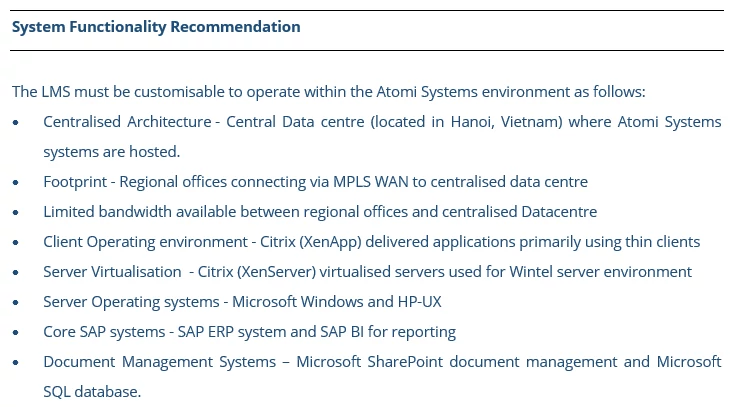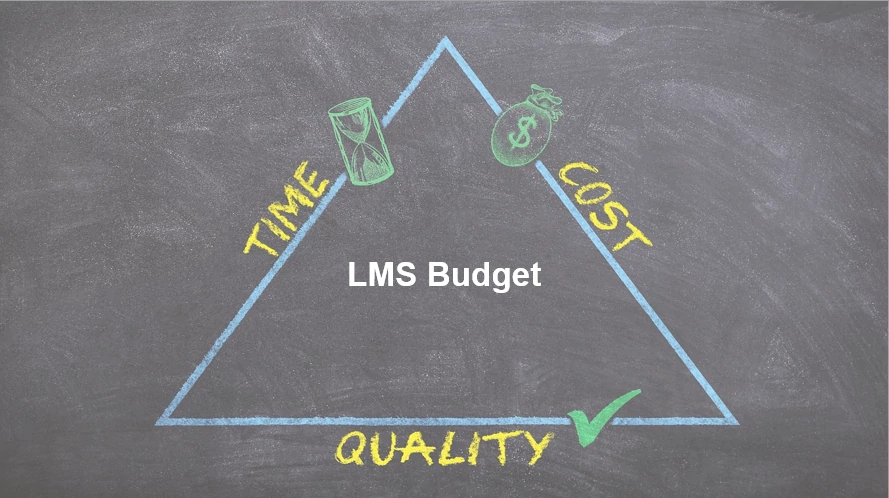It’s easy to say “We need an LMS”, but it’s hard to choose a right LMS. In fact, buying an ideal LMS can be a huge investment, not to mention a tough challenge. So, you should research thoroughly before making a decision.
To help you save time and effort for this task, below are some useful tips to pick the right learning management system (LMS). Using them, you’ll find your ideal one soon.
In this blog:
- Define your goals and needs in advance
- Design learner personas
- Create an accurate LMS budget
- Consider tracking and reporting capabilities
- Think about support services
Let’s dive deep into each of these.
Define Your Goals and Needs in Advance
Before you start searching for an LMS, ponder your goals and needs. That is, try to answer some questions like these: What are our core education and learning objectives? Why do we decide to buy an LMS? What features do we wish to have in your ideal LMS? Is there any technical standard or constraint in our organization? Once you clarify your expectations, it’s a good strategy to create an LMS Request for Information (RFI). This way, you can build a requirement checklist to narrow down your list of potential LMS solutions.
Generally, an RFI is a document used to gather information about functionality considerations for your new LMS. To utilize the benefits of RFI, mind these:
- Give a general overview of your organization, including mission statement, products/services, current training strategy, and number of employees.
- List all of your required features. Be as specific as possible and use statements instead of questions. Here is an example.
In case you want to replace your current LMS, remember to ask your learners what they love most about your current LMS and what they expect to see improved. Then, put these pieces of information into your RFI.
When you’ve created an RFI, just send it to LMS vendors and wait for responses. Based on their answers, you will define which LMSes can meet your goals and needs.
Design Learner Personas
If you don’t know exactly who you want to teach, how can you create the best learning experience for them? Do you know different learners learn with different goals and call for different features? Those questions are reasons why you need to specify your target learners when looking for an LMS.
An effective way to get informed about your learners is create learner personas. In a word, a learner persona is a generalized presentation of your ideal learners. It should include data like learner names, demographics (age, gender, ethnicity, college, etc.), workday flow, devices which they use most, and how these devices are used during a day. Using learner personas, you can identify their learning behaviors and choose an LMS which serves their needs. For example, if a learner usually accesses eLearning courses through mobile devices, it’s wise to go with LMSes which support mobile delivery.
In addition, you should define whether your learners are tech-savvy or not. If not, you need to adjust your strategy for those who aren’t familiar with eLearning. Generally, learners often want something that’s user-friendly and simple-to-use. They wish to interact with teachers/fellows and keep track of their own learning progress easily. All these things impact on your choice of LMS.
Create an Accurate LMS Budget
As said earlier, buying an LMS may be a very expensive part of an eLearning development plan, in most cases. A research of Brandon Hall Group even found that LMSes made up 38% of the average learning technology budget. With these in mind, you should craft an accurate budget for your LMS solution. More specifically, you’d better mind the true cost of an LMS.
In a word, the true cost of an LMS includes two types of costs: hard costs and hidden costs. Each type can be up to thousands of dollars.
Hard Costs
They are the costs which “everyone knows” – any setup fees, licensing fees, or pricing models.
- Setup fees are one-off costs to install and configure an LMS. They can be a one-time or periodical fee depending on LMS vendors.
- Licensing fees are renewed, either on a biannual or annual basis. They keep the contract valid and ensure all learners can continue to use learning materials on the LMS.
- There are many pricing models, depending on types of LMS (self-hosted or cloud-hosted). Some of them are pay per learner, pay per use, and free. In case you opt for a free LMS, you should keep in mind that it’s usually less intuitive. As such, it requires technical knowledge and experience to make the most of features. There are even no support services available, so maintenance may be expensive.
Analyzing these costs can take much time and make you frustrated. Added to that, no pricing model is necessarily better than any other as this is subject to your needs. So, carefully think about what you want before making the final decision.
Hidden Costs
Hidden costs of an LMS indicate all costs that you only know after you choose an LMS. Some hidden costs are:
- Time: Let’s say you choose an LMS with no initial cost. If setting up and implementing it take up large chunks of time, it may become expensive. Instead, purchase an LMS that match with your organization’s processes.
- Staff training: Even the most user-friendly tools demand some level of training. Training is so important if your staff is unfamiliar with new LMS or they’ve never used an LMS before.
- Upgrades and add-ons: Sometimes, upgrades cost a lot of money. Installing add-ons is no different. In some cases, it’s hard to pick up a good add-on since there are so many options.
So, pay attention to these types of costs when creating an LMS budget. Make sure you know how much you’re willing and how you can efficiently allocate your resources.
Consider Tracking and Reporting Capabilities
Ideally, you’ll want an LMS with the facility to track data and provide reports. Hence, you can measure learner performance and give learners feedback on where they need to improve. For this reason, you should give thought to tracking and reporting features when finding an LMS.
To assess tracking capabilities of an LMS, consider what kind of information it can track. Do you wish it to track final score, bookmarking, course status, attempts, or anything else? Does it allow you to export reports in different formats like PDF and CSV? Do you want an xAPI-enabled LMS with more powerful tracking features or just a SCORM-enable LMS to track data online? Take time to answer these questions.
At the same time, an LMS with a powerful reporting system brings you great benefits. That is, you’re free to remove or add any field in your report you want. There are pre-set fields so you can create a new report in a flash. In addition, reports also need to come to the point without containing any unnecessary data. Some types of reports you should know are course reports, active users, login activities, user’s progress, enrolment, and assessment.
Some LMSes now let you schedule the time of automatically generating reports (daily, weekly, or monthly). Don’t miss them out!
Think about Support Services
Support is something which first-time LMS buyers often ignore until they need it. However, it’s highly recommended to take notice of support services beforehand.
How much support do you expect from the LMS vendor? Which support services are included if you select any package? Do you have to purchase any add-on like 24/7 phone assistant? Will the vendor guide you through the setup process? Can you call them if you struggle with a technical problem? There are a lot of things to consider when it comes to support.
To thoroughly evaluate customer service of an LMS vendor, test it out by yourself first. You can ask a question in the online community or make a phone call. How they help you solve your problem (including quality of information and the speed to response) will show you the level of care you can expect if you become their customer.
Likewise, don’t forget to check which types of documentation the LMS vendor provides. They will help you a lot in the process of managing and operating the LMS.
Additional Tips:
- Consider the profile and experience of LMS vendors. Ask them to provide relating information and find any reviews/ratings for LMSes and companies.
- Ask for a live demonstration or a trial period. That way, you can see the LMS in action and determine features as well as functions which are in-line with your needs.
- Get reviews about LMSes on online forums/communities, read relevant articles/comments, or watch review videos to get a clear sense of LMSes.
Hope this blog gives you useful techniques to choose an LMS which best suits your needs. If you know other tips and tricks, don’t hesitate to share with us.




